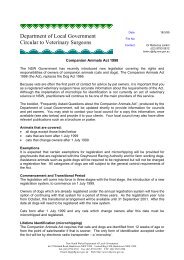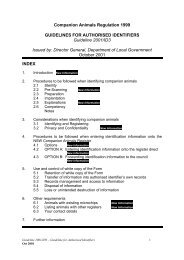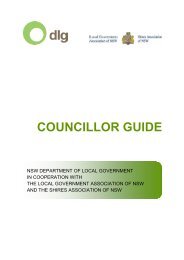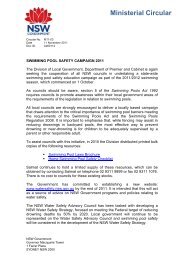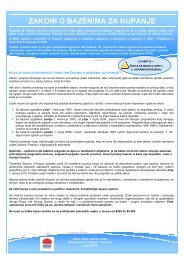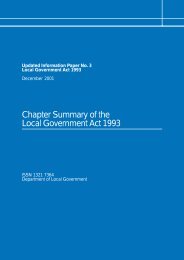Integrated Planning and Reporting Manual - Division of Local ...
Integrated Planning and Reporting Manual - Division of Local ...
Integrated Planning and Reporting Manual - Division of Local ...
You also want an ePaper? Increase the reach of your titles
YUMPU automatically turns print PDFs into web optimized ePapers that Google loves.
2. THE COMMUNITY STRATEGIC PLAN<br />
They can do this by:<br />
ensuring that a broad range <strong>of</strong> community members have input into developing the Plan<br />
specifically consulting with those groups whose voice is <strong>of</strong>ten not heard in community<br />
discussions<br />
testing the objectives <strong>of</strong> the Plan against the four principles – are the objectives fair Do they<br />
exclude anyone from participating in the community’s future Would anyone be<br />
disadvantaged by these decisions<br />
ensuring that the Community Strategic Plan is adequately informed by sound social research<br />
<strong>and</strong> needs analysis<br />
ensuring that the Community Strategic Plan provides opportunities for community members<br />
to become involved in its delivery <strong>and</strong> assessment <strong>of</strong> its effectiveness in achieving its<br />
objectives.<br />
In practice, this means that much <strong>of</strong> the work previously undertaken for the Social <strong>and</strong> Community<br />
Plan will now be incorporated into the Community Strategic <strong>Planning</strong> process. Councils should<br />
continue to refer to the guidance in the Social <strong>and</strong> Community <strong>Planning</strong> <strong>and</strong> <strong>Reporting</strong> <strong>Manual</strong>,<br />
DLG, 2002. In particular, the demographic pr<strong>of</strong>ile, needs assessment <strong>and</strong> consultation guidance<br />
remains relevant.<br />
2.5 The four key areas – addressing the quadruple bottom line<br />
<strong>Local</strong> Government Act<br />
The Community Strategic Plan must address social, environmental, economic <strong>and</strong> civic leadership<br />
issues in an integrated manner.<br />
Each Community Strategic Plan must adequately address social, environmental, economic <strong>and</strong> civic<br />
leadership considerations. This approach is generally referred to as ‘the quadruple bottom line’. In<br />
some models the fourth element is described as ‘governance’. In the new planning framework, the<br />
term ‘civic leadership’ has been chosen to indicate it relates not only to the way that Council will<br />
interact with the Community Strategic Plan, but the way that members <strong>of</strong> the community might<br />
become involved in delivering some <strong>of</strong> the Plan’s objectives.<br />
The quadruple bottom line approach was chosen to ensure that the Community Strategic Plan<br />
would be balanced <strong>and</strong> take a holistic view, rather than favouring one particular aspect. Councils<br />
can arrange their Community Strategic Plan in any way they like, as long as they can demonstrate<br />
that social, environmental, economic <strong>and</strong> civic leadership issues have been considered <strong>and</strong> are<br />
adequately addressed. There are a number <strong>of</strong> ways <strong>of</strong> doing this.<br />
Basic approach<br />
The simplest way is to group items that Council <strong>and</strong> the community want to consider under the four<br />
key headings to make sure there is an adequate range under each heading. For example, when<br />
setting out its Community Strategic Plan, a larger council might draw up a table like the one on the<br />
following page.<br />
<strong>Planning</strong> & <strong>Reporting</strong> <strong>Manual</strong> Page 25 <strong>of</strong> 115






